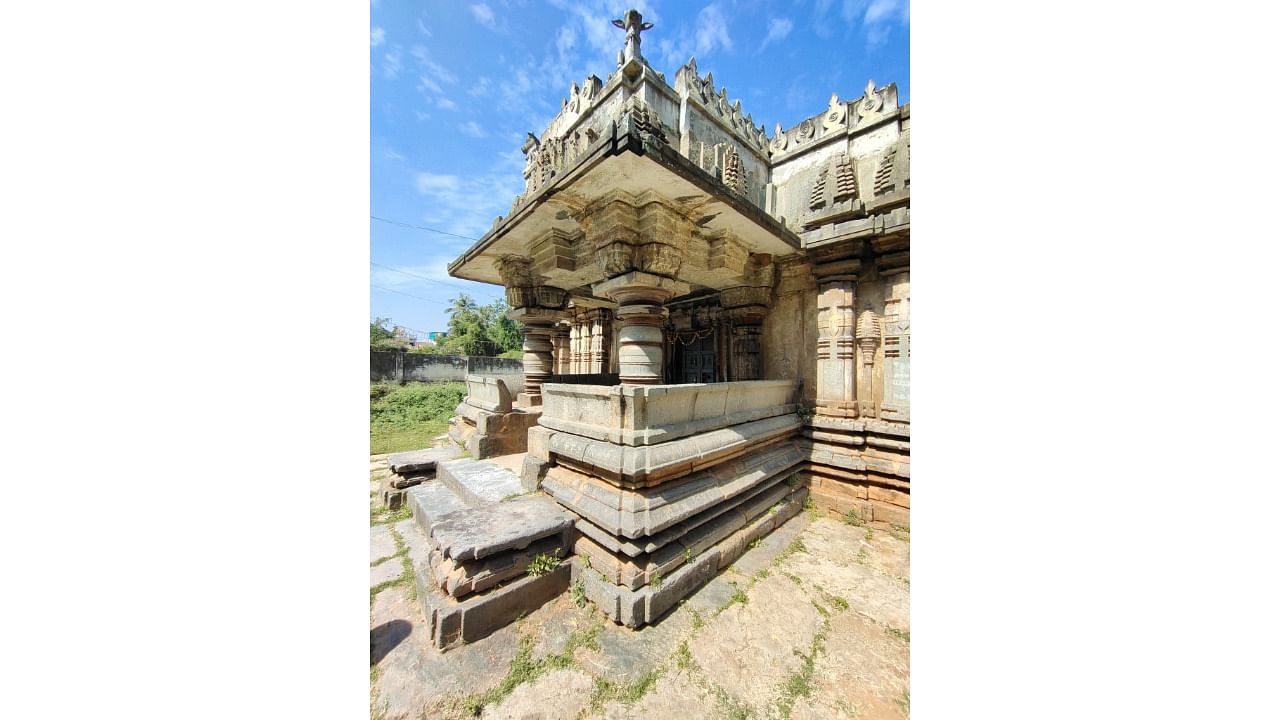
The south-facing mukhamantapa of the Moole Shankareshwara temple.
Credit: Special Arrangement
The first thing that one notices about the Moole Shankareshwara temple at Turuvekere in Tumakuru district is its unique shikhara. This Saiva temple was built in the mid-13th century CE, during the period of Hoysala rule in the region. There is also a Vaishnava temple here, called the Chennigaraya temple, built roughly around the same time. Both temples have a similar planform, with a sanctum, a closed mantapa and a mukhamantapa or porch. The vimanas, or outer envelopes of the sanctums of both temples, are of the type known as semi-stellate — while the central projections as well as corners are orthogonal, the intervening projections between these correspond to rotated squares, giving them a partially stellate form.
However, the Chennigaraya temple has a shikhara conforming to the Karnata Dravida form popular in typical Hoysala temples, while the Moole Shankareshwara temple has a Hoysala interpretation of the Bhumija shikhara, a form which was popular in Central India under the northern tradition of temple-building.
Though both the temples are aligned east-west, the mukhamantapa granting entry to the Chennigaraya temple is in the east, while that of the Shankareshwara temple is in the south. This leaves the eastern wall of the latter blank, with a small opening carved in its centre. This opening runs through the entire thickness of the wall — 1.6 m, and is aimed precisely at the linga in the sanctum. Could this be for devotees to glimpse the linga even when the temple is closed? The alignment of the temple — accurately facing cardinal east, suggests another possibility — perhaps the opening was created to channel the rays of the rising sun onto the idol. At any given location, the sun rises in the cardinal east only on equinox days, roughly around March 21 and September 23, and it is on these days that the rays of the rising sun would illuminate the linga.
Lit up by the rays
We decided to test this hypothesis during the spring equinox of 2022. To our consternation, the temple was being dismantled and reassembled as part of a restoration drive. Fortunately, the lower part, including the walls, was intact. A dhvaja stambha from a later period, probably Vijayanagara, obscured part of the opening as seen from inside, and unfortunately, the compound wall obstructed the rest of the opening. However, technology came to the rescue, and a mobile phone app for stargazing confirmed that the rising equinoctial sun was indeed framed in the centre of the opening.
At Nagalapura, also in Turuvekere taluk and less than 10 km south of Turuvekere town, is another set of Hoysala temples, roughly contemporaneous with the Turuvekere temples. Here too, the temples are Vaishnava and Saiva — the Chennakeshava and Kedareshwara respectively. It is intriguing to note that the layouts and alignments of both temples are identical with the temples at Turuvekere – the Vaishnava temple has its entry from the east, and the Saiva temple from the south. The blank eastern wall of the Kedareshwara temple also has an opening aligned with the linga. Here, too, the deity would be lit by the rising sun during the equinoxes, but for an obstruction in the form of a large tree in the east.
The location of both the Moole Shankareshwara temple at Turuvekere and the Kedareshwara at Nagalapura on the western banks of large water bodies further supports the idea that the apertures were for admitting the sun’s rays to illuminate the idol, for this would have ensured a clear horizon to the east.
More examples nearby
Another Hoysala temple in the vicinity — the Sadashiva temple at Nuggehalli, around 28 km to the southwest of Turuvekere, predates both the Shankareshwara and Kedareshwara. Built in 1246 CE, the Sadashiva is another of the rare Hoysala temples to have northern-style Bhumija shikharas. It is indeed possible that some of the artisans who worked on this temple would have also worked on the Shankareshwara. Inscriptional evidence suggests that Baichoja, one of the artisans who worked on the corresponding Vaishnava temple at Nuggehalli, also worked on the Kedareshwara at Nagalapura. It is quite likely that there were many artisans who worked at all three sites, given the proximity in space and time.
The Sadashiva temple is also aligned east-west, with an entry into the closed mantapa from the south, and a Nandi mantapa in the east. This Nandi mantapa has pierced screens on three sides, which would permit the light from the rising sun to fall on the deity. Did those intrepid architects conceive the idea for illuminating the linga with the sun’s rays by observing this phenomenon at the Sadashiva temple, which was built earlier?
Interestingly, Shrinivas Padigar, the eminent art historian, pointed out that in several dvikuta temples (those with two shrines) of Pashupata Saiva affiliation, it is invariably Surya who is installed in the shrine opposite the main one. Daily Saiva worship commenced by paying respects to Surya. One such example from the Hoysala period is the Bucheshwara temple at Koravangala, where an idol of Surya faces the linga in the main shrine.
It is often presumed that temple architects in India, bound as they were by well-structured canons, had little room for individual agency in their creations. Those ingenious artisans of Turuvekere, who did away with any icon of the Sun-God, and invited Surya himself to stream in and light up the deity in the dark sanctum, suggest otherwise.
(The author is with the National Institute of Advanced Studies, Bengaluru.)